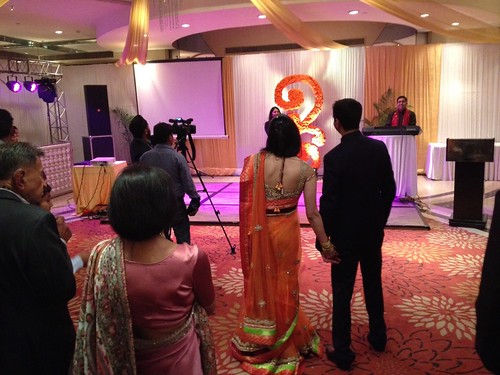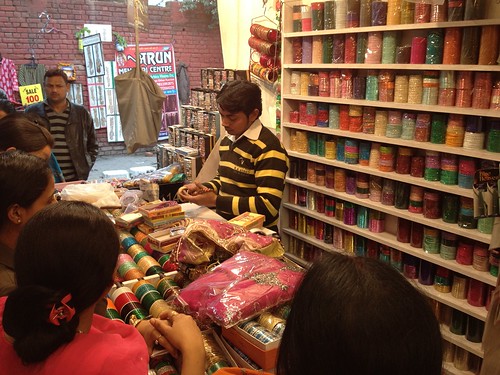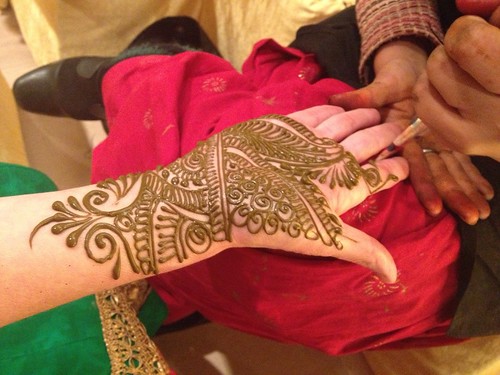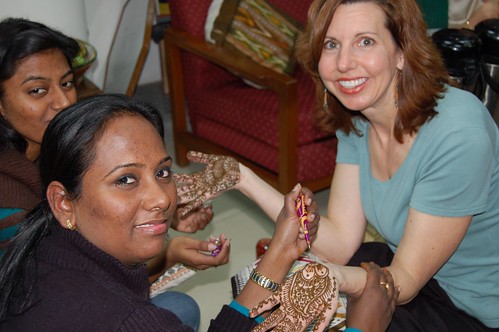As we wrap up a week of wedding festivities, I hardly know how to start writing about it. Like everything in India, the events were hard to process at the time.
Our landlord, Ashwani, and his wife, Alka, live downstairs with their daughter, Sanaa. Sanaa completed a master’s degree in England last year, returned to work in Delhi and recently announced her plans to marry childhood friend, Madhavkrishna. The proud parents invited us to three of the celebrations: Mehendi on Monday, Sangeet on Wednesday, and the wedding ceremony on Thursday. This was our first wedding in India, so we had absolutely no idea what to expect.
Workers draped the entire house in lights, and enclosed the courtyard with orange and gold fabric, woven to create a roof and walls. Garlands of marigolds and jasmine adorned the courtyard and stairwell.

Last week, I had a quick chat with Alka, mother of the bride. I was feeling anxious about what to wear to these events, and Alka calmly assured me that whatever I wore would be fine. (Note to all Indian women: You do foreigners a big disservice by acting so nonchalant about such things. Please, I beg you, give us explicit instructions about how to comply with your cultural norms.)
Alka told me a “suit” would be appropriate for Monday’s mehendi party. “Suit” does not imply an Ally McBeal mini-skirt and jacket, as it did in the States back in the days I actually wore business suits. In India, a suit is a long top with blousy pants. This outfit ranges from relatively casual embroidered cotton to flowy embellished chiffon. With that in mind, I planned to wear my gray silk kurta (long top) and mauve choridar (tight-legged pants that gather at the ankle). Fortunately, I sought advice one more time from a cousin visiting from the States for the wedding. “It’ll be pretty fancy,” she said.
Panic set in. Right after school, I dashed off to Sarojini Market and popped in to a tiny dress shop. The salesclerk plopped one kurta after another on the counter, but my brain froze. I didn’t even know what to ask for. Finally I blurted, “I’m going to a mehendi party TONIGHT!” He swept all the kurtas off the counter and said, “Come in.” At the back of the shop, he started pulling packages off the shelves, whipping the brightly-colored garments out of the plastic and piling them in front of me. “This is the latest fashion,” he said. I picked one, tried it on over my dress, and realized it needed a little altering.
“Ten minutes,” the shopkeeper said. He then walked me around the corner to a bangle shop, which was packed with ladies. The bangle man stood behind a glass display case, surrounded by thousands of bangles in every size, color and degree of bling. Each lady in turn placed an item of clothing on the counter, and he quickly darted around his tiny space, pulling bracelets off the shelves and yelling requests to a worker in a storage space upstairs, who lowered bags of bangles through a hole in the awning. The banglemeister shuffled the delicate bracelets like cards, masterfully color-coordinating and arranging them on a wooden dowel, which he then held up to the light to dazzle the customer. I waited about 30 minutes for my turn. In the meantime, Tony had brought my perfectly altered dress (called an “anarkali”), so taking my cue from the Indian ladies, I placed it on the counter. Bangle Man gently felt my hand to determine the size and then flitted about, collecting fuchsia, black, green and gold bangles of varying widths and flashiness. I bought 20 bangles for each arm, which turned out to be excessive, but I couldn’t resist!
Tony was an extremely reluctant chaperone on this night because his Indian colleagues at school had told him this was a ladies-only event. In fact, my online research supports their claims. Based on what I read, I was expecting an intimate but lively evening with ladies sprawled out on cushions, offering marriage advice to young Sanaa while classical musicians played in the background and mehendi artists painted henna designs on our hands. However, father-of-the-bride Ashwani explicitly invited Tony to the mehendi party. See why confusion is our constant companion in India?
The mehendi party took place at a hotel, and the minute we stepped into the foyer, I knew we were out of our league. Far from intimate, the hotel ballroom filled with more than a hundred guests. My new anarkali felt extremely casual among ladies draped in saris and dripping with jewels. Feeling self-conscious, I quickly left the crowd to get my hands painted. The one fabulous part of my outfit – the glittery bangles – only made a brief appearance, as I had to remove them for mehendi. For most of the night, I walked around with wet henna, unable to hold a glass or eat any of the appetizers. While Tony took advantage of the open bar and omnipresent strolling waiters, I let go of my wardrobe worries and chatted with other guests, trying not to smear the mehendi. Eventually, I brushed off some of the crusty dried henna to sample the snacks and wine, but I learned my lesson. The more experienced wedding-goers explained that I should only get one hand painted next time to free up the other hand for eating and drinking.
The bride’s brother, Karan, gave a sweet speech about his little sister, and the crowd began to dance.
Tony and I felt humbled by the family’s kindness and inclusive spirit. We never stood alone or felt left out, and we enjoyed interesting conversations with visitors from all over the world, including Denver, San Francisco, Singapore and other cities in India. Shortly before midnight, we said our good-byes.
“You’re not staying for the dinner?” people asked.
We didn’t even realize they were serving dinner! But, no thank you, we told them. It was already way past our bed time on a school night, and we knew it was going to be a long week.
I brushed off the dry mehendi a bit prematurely, and I didn’t coat my hands in oil before going to bed, so the henna design isn’t as vibrant as it otherwise would have been. Still fantastic, though!
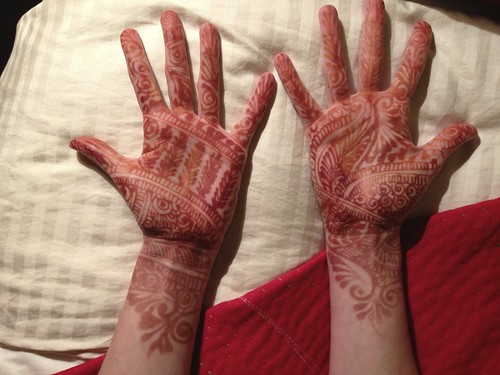
This is a bad photo taken with Tony’s phone while I was trying not to mess up my hands, but I wanted to show Sanaa’s beautiful orange sari. She and her groom-to-be were watching the entertainment.
